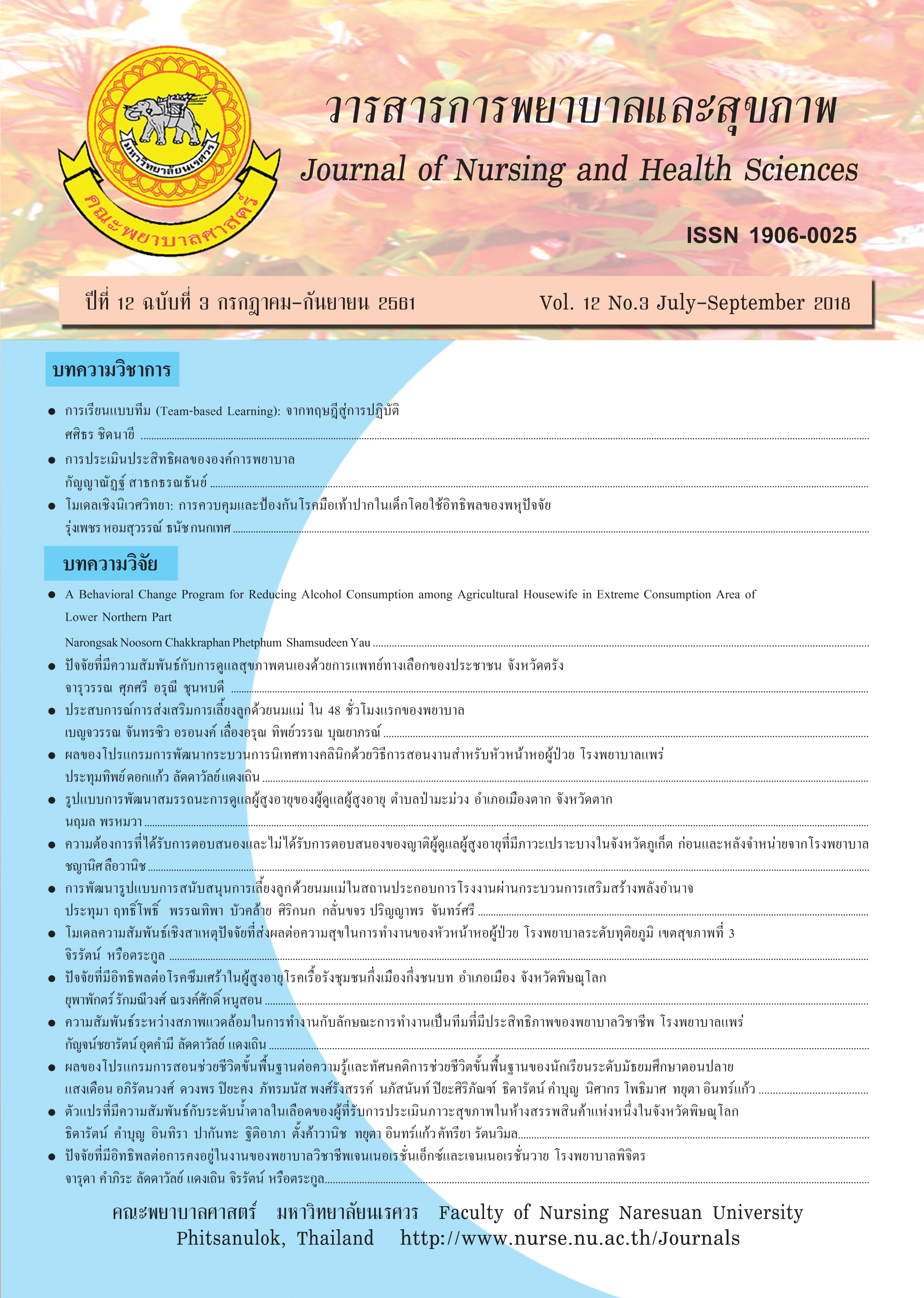Factors Influencing Depression in the Elderly with Chronic Diseases in Sub-urban Area, Muang District, Phitsanulok Province
Main Article Content
Abstract
The purposes of this predictive research was to examine factors affecting depression in the elderly with chronic diseases in sub-urban communities in Muang District, Phitsanulok Province. The sample group, derived from multi stage cluster sampling, consisted of 340 elders with the top 4 chronic diseases found in Phitsanulok Province, namely hypertension, osteoarthritis, coronary heart disease and diabetes, and with no symptom of dementia. Data were collected using a questionnaire of general demographic, social and economic information, a 9Q depression assessment form, and an assessment form for knowledge, attitudes, perception of risks, mental health promotion behavior, automatic negative thoughts, self-esteem, achievement motivation and social support. The study was conducted from November 2016 to February 2017, using quantitative methods of data collection. The quantitative data were statistically analyzed using frequency, percentage, mean, standard deviation. Pearson 's product moment correlation and the factors influencing depression were analyzed using Stepwise multiple regression analysis. Findings revealed that the variables influencing depression in the elderly with chronic diseases were behaviors concerning the promotion of depression prevention (Xc), automatic negative thoughts (Xe) and self-esteem in the elderly with chronic diseases (Xf) respectively. Behaviors concerning the promotion of mental health for the prevention of depression was the variable with the highest predictive power for depression in the elderly with chronic diseases, The variables in overall had the predictive influence on the prevalence of depression at 61.60% (adjusted R2 = 0.616). The equation of predicting factors is as shown: Y = 2.269 + .511Xc + .723Xe + .088Xf Z = .612Xc + .379Xe +.007Xf
Article Details
References
การรณรงค์เพื่อเสริมสร้างสุขภาพจิตวัยทำงาน
และวัยสูงอายุในพื้นที่. สืบค้นเมื่อ 18 สิงหาคม
2559, จาก http://www.klb.dmh.go.th/modules.
php?m=technology&gr=&op=detail&
researchId =870
ณรงค์ศักดิ์ หนูสอน. (2553). การส่งเสริมสุขภาพในชุมชน
แนวคิดและการปฏิบัติ. กรุงเทพฯ: จุฬาลงกรณ์
มหาวิทยาลัย.
เทพฤทธิ์ วงศ์ภูมิ, จักรกฤษณ์ สุขยิ่ง, และอุมาพร
อุดมทรัพยากุล.(2554). โรคซึมเศร้าในประชากร
สูงอายุ จังหวัดเชียงใหม่, วารสารสมาคมจิตแพทย์
แห่งประเทศไทยวาร, 56(2), 103-116.
นริสา วงศ์พนารักษ์, และ สายสมร เฉลยกิตติ. (2557).
ภาวะซึมเศร้า:ปัญหาสุขภาพจิตสำคัญในผู้สูงอายุ.
วารสารพยาบาลทหารบก, 15 (3), 24-31.
นิตยา จรัสแสง, เพชรรัตน์ บุตะเขียว, และพรนิภา
หาญละคร. (2555). ภาวะซึมเศร้าในผู้ป่วย
เรื้อรัง. สมาคมจิตแพทย์แห่งประเทศไทย,
57(4), 439-446.
ปราโมทย์ ประสาทกุล (2554).สถานการณ์ประชากร
ของประเทศไทย พ.ศ. 2554 ใน ประชากรและ
สังคม 2554 ใน สุรีย์พร พันพึ่ง, มาลี สันภูวรรณ์
(บรรณาธิการ), ประชากรและสังคม 2554:
ประชากรของประเทศไทย ณ.พ.ศ. 2554.
นครปฐม: สถาบันวิจัยประชากรและสังคม
มหาวิทยาลัยมหิดล
เพ็ญพร สายวิจิตรและยุวยงค์ จันทรวิจิตร. (2560).
ผลของโปรแกรมส่งเสริมสุขภาพด้านอาหาร
ต่อพฤติกรรมการบริโภคอาหารและระดับ
คอเลสเตอรอลในเกษตรกรกลุ่มเสี่ยง ตำบล
ทะนง อำเภอโพทะเล จังหวัดพิจิตร. วารสาร
การพยาบาลและ สุขภาพ, 11(2), 18-41.
มติชนออนไลน์. (2560). รายงานเรื่อง วิถีใหม่ “ผู้สูง
อายุ” ยุค 4.0 ส่งความสุขแบบ “ออนไลน์”
เชื่อมสัมพันธ์ครอบครัว สืบค้นเมื่อ31สิงหาคม
2560, จากhttps://www.matichon.co.th/news/
มหาวิทยาลัยมหิดล. (2554). ข้อมูลประชากรใน
ประเทศไทย. สืบค้น 21 มีนาคม 2558 จาก
http://www.ipsr.mahidol.ac.th/ipsr-th/
population_thai.html
ยุพาพักตร์ รักมณีวงศ์. (2547). การพัฒนารูปแบบการให้
คำาปรึกษารายบุคคลตามแนวคิดการปรับ
พฤติกรรม ทางปัญญาโดยใช้การฝึกสมาธิแบบ
ลมหายใจเป็น ต่อการลดภาวะซึมเศร้าในผู้ป่วย
อัมพาต.วิทยานิพนธ์ ปริญญาพยาบาลศาสตร
มหาบัณฑิต สาขาการพยาบาลสุขภาพจิตและ
จิตเวช, บัณฑิตวิทยาลัย มหาวิทยาลัยขอนแก่น.
ยุพาพักตร์ รักมณีวงศ์. (2555). ภาวะซึมเศร้าและ
ความคิดอัตโนมัติด้านลบ รากเหง้าของปัญหา.
วารสารการพยาบาลและสุขภาพ, 7(1), 7-24.
สุกัญญา มาลัยมาตร. (2554). ผลของโปรแกรมการสร้าง
เสริมพลังอำนาจต่อพฤติกรรมการดูแลตนเอง
และความเจ็บปวดข้อเข่าผู้สูงอายุโรคข้อเข่าเสื่อม.
วิทยานิพนธ์ ปริญญาพยาบาลศาสตรมหาบัณฑิต
สาขาวิชาการพยาบาลเวชปฏิบัติชุมชน, บัณฑิต
วิทยาลัย มหาวิทยาลัยนเรศวร.
สำนักงานสถิติแห่งชาติ. (2557). รายงานสถานการณ์
ผู้สูงอายุไทย ปี 2557. กรุงเทพฯ: สำนักงานสถิติ
แห่งชาติ.
สำนักงานสาธารณสุขจังหวัดพิษณุโลก. (2559). รายงาน
สถานการณ์ผู้สูงอายุโรคเรื้อรัง ปี 2559. พิษณุโลก.
สมศักดิ์ ชุณหรัศมิ์ และคณะ. (2552). สถานการณ์ด้าน
สุขภาพของผู้สูงอายุ.ใน สมศักดิ์ ชุณหรัศมิ์
(บรรณาธิการ), สถานการณ์ผู้สูงอายุไทย พ.ศ.
2552 (หน้า 28-53). กรุงเทพฯ: มูลนิธิสถาบันวิจัย
และพัฒนาผู้สูงอายุไทย.
อณัศยา ซื่อตรง และทัศนา ชูวรรธนะปกรณ์.(2559).
ปัจจัยทำนายคุณภาพชีวิตของผู้สูงอายุที่มีภาวะ
หัวใจล้มเหลว วารสารพยาบาลโรคหัวใจและ
ทรวงอก, 27(2): 58-70.
American Psychiatric Association. (2000). Practice
guideline for the treatment of patients with
major depressive disorder (2nd ed., p. 356).
Washington, DC: American Psychiatric
Association.
An Aging World. (2015). International population
reports ; Issued March 2016. U.S. Government
Publishing Office, Washington, DC. Retrieved
September, 09, 2016 from https://www. census.
gov/content/dam/Census/library/publications/
2016/demo/p95-16-1.pdf
Beck, A.T. (1967). Depression: Clinical, experimental
and theoretical aspects. New York: Hoeber
medical division.
Bloom, B.S. (1964). Taxonomy of education objective :
Cognitive domain. New York: David McKey
Brandt, P., A., & Weinert, C. (1985). Psychometric
update, unpublished manuscript. Washington
D.C.: University of Washington, School of
Nursing.
Coopersmith, S. (1984). Self-esteem inventories (2nd ed.).
California: Consulting Psychologists Press.
Murray, C. J. L., & Lopez, A. D. (1996). The Global
burden of disease: A comprehensive assessment
of mortality and disability from disease, injury,
and risk factor in 1990 and projected to 2020.
Global Burden of Disease and Injury Series,
vol. 1. Cambridge: Harvard University press.
Pender, N.J. (1996). Health Promotion in Nursing
Practice (3rded.). New York: Appleton and
Lange.
Pender, N. J., Murdaugh, C. L., & Parsons, M. A.
(2011). Health promotion in nursing practice.
(6th ed). Boston, Massachusetts: Pearson.
Perala, S. J., Saarni, S.I., et al. (2007). Lifetime
prevalence of psychotic and bipolar 1 disorders
in a general population. Arch Gen Psychiatry,
64, 19-28.
Richard G., Moore & Anne, G. (2003). Cognitive
therapy.Textbook of psychiatry (3rded., pp.
1205-1241). Washington, DC: American
Psychiatric and Press.
Rybarczyk, B., Andrea M. Garroway M.S, Stephen M.
A., Vivian M. R., Sadock, E., et al. (2013).
Primary care psychology : An opportunity for
closing the gap in mental health services for
older adults, Clinical Gerontologist, 36, 195-215.
Stuart.,R. (1984). Cognitive behavior therapy. M.C.
Escher/Cordon Art, Baarn, Honlland. Retrieved
01, 09, 2015 from http://psycnet.apa.org/
search?fa=main.doiLanding&uid=1986-
12531-001
Sudnongbua, S., LaGrow, S., & Boddy, D. (2010).
Feelings of abandonment and quality of life
among older persons in Rural Northeast
Thailand, J Cross Cult Gerontol, 25, 257-269.
World Health Organization. (2010). Mental health
development: Targeting people with mental
health conditions as a vulnerable group. Mental
health and poverty project. USA.: World Health
Organization.


